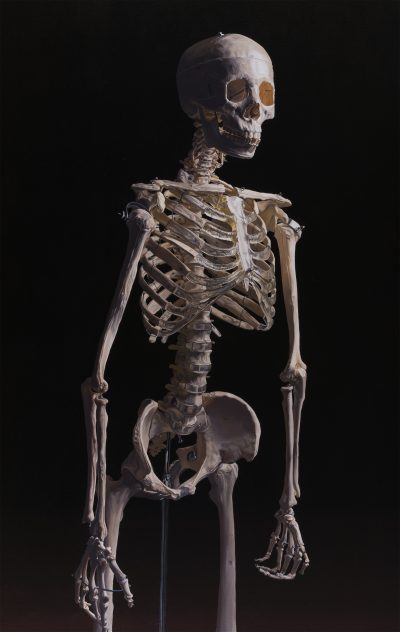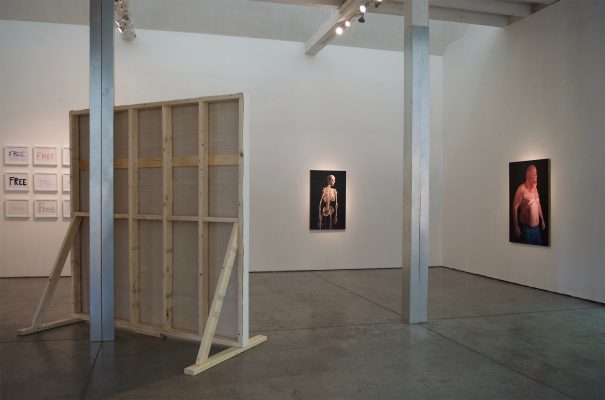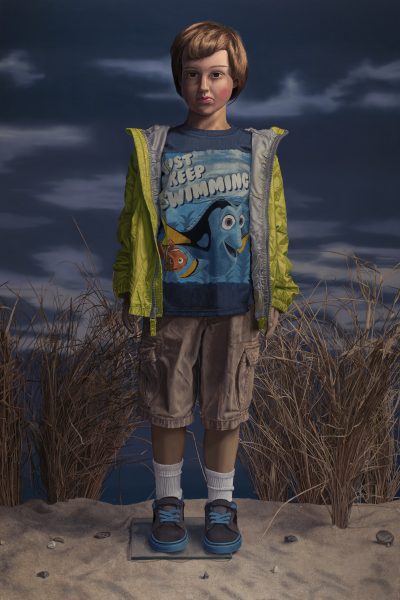Uncertain Terms: Philip Brou’s “Letting Yourself Go”

By Olivia J. Kiers
Philip Brou’s first solo exhibition, Letting Yourself Go, at Corey Daniels Gallery in Wells, ME, is a conceptually dense exhibition rendered into a handful of precise elements that elude summary. Each work is so filled with the artist’s inquiry into the human condition that one must move through it slowly in order to absorb half of what he might have intended. From the very start, the show attempts to destabilize the viewer by positioning two large, temporary walls in such a way that the viewer enters the space from what feels like backstage. From there, things only become more unusual and, for the open-minded viewer, fascinating.

Connections across the works on view are both cerebral and visual. Free, a “haiku” of paper signs that Brou collected from sidewalks, shouts out the word “free” 17 times until the word begins to take on mysterious significance. Across the gallery on a tabletop, another Free consists of dirt collected from the graveyard in Richmond, VA, at the church where founding father Patrick Henry delivered his famous line, “Give me liberty or give me death.” Richmond was also once the seat of the Confederacy—the longer you contemplate this single word written in dirt, the more layers of history converge and complicate the work’s meaning. Next to it, yet another Free—a wooden sign floating upside-down in a tank of saltwater from the Atlantic. The viewer must strain to see the word mirrored on the bottom, and from certain angles it appears to say something else—“LIFE,” or perhaps “FLEE.” While themes of emigration from Europe, slavery and the African diaspora aren’t mentioned in the exhibition materials, it’s tempting to read them into these two works’ confluence of Atlantic water and American soil. Or, viewers might regard these repetitions as an examination of one word’s conflicting, albeit related, valences. The state of being free is to be without value. Said another way, freedom is priceless.

Brou buries many double-meanings within his art, and it was easy for this viewer to latch onto certain themes, racing towards her own theories and conclusions. His works encourage the search for an “Ah ha!” moment, whether or not the viewer’s realization coincides with that of the artist. Yet as the gallery co-director and curator Sarah Bouchard explains, for her, “so much of the work is busting open the idea of how identity is constructed, and it doesn’t lead to answers. It just leads to more questions.”
Another grandiose question the exhibition explores is the concept of the “Nemo” (or “Nobody”), a reference to an episode in Homer’s Odyssey. What does it mean to be or to become a Nobody? Brou commissioned two self-portraits from forensic artists by giving them a verbal description of himself; he then titled both of the resulting drawings i. They have a resemblance to one another, while also sharing that blank expression common to forensic art. Without conveying the subject’s emotion, the portraits leave the viewer free (again, free) to read preconceived notions about forensic portraiture within Brou’s face. Bouchard described them as vulnerable and fragile. I saw them as menacing.

Three masterfully rendered, photo-realist paintings continue Brou’s exploration of the Nemo. Just Keep Swimming depicts a mannequin dressed in a boy’s Finding Nemo shirt, a reference to the popular animated film about a lost fish and his father’s search to find him. It takes time to determine what exactly is wrong with the painting. Many of the details make this appear to be a real child. The jacket is undone and droops off the shoulders with a convincing carelessness. Yet like the forensic portraits, there is no real emotion that can be read in the mannequin’s face—there is no real boy. The recreation of a human being is right there in front of us, but this is essentially a portrait of absence. In two additional paintings (one also titled i, the other It’s Later Than You Think), Brou paints himself, shirtless and wearing a Cyclops mask (another Odyssey reference), and a skeleton that duplicates his stance. Brou’s obscuring of the face blocks one of the most fundamental way humans connect with one another. A grinning skull and a rubber mask are poor stand-ins for the human gaze. Yet these are still compelling portraits for their luminous rendering and intense detail. With the basic instinct to look at the subject’s face diverted, viewers are freed (once again) to seek information elsewhere, in the penciled number on a bone perhaps, or in the curl of an individual chest hair.
Letting Yourself Go is as much a directive to the viewer as it is a description of Brou’s inquiry. There is an uncanny, uncertain territory to explore within each of the works on view, and in the layered dialogue that they hold with each other. It is best to let go of one’s certainties before entering.
Letting Yourself Go is on view at Corey Daniels Gallery through August 4, 2018.
